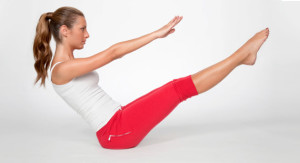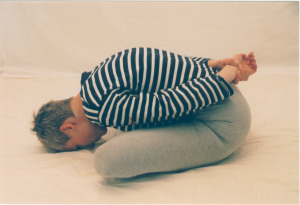What is Padma Sadhna? It is a Hindi term (Hindi is a national language of India). Padma means lotus and Sadhna is effort. And is the art of experiencing meditation through yoga postures. The yoga postures in Padma Sadhna is such that one posture compliments the other. So it’s important to follow the sequence that has been set by Sri Sri Ravi Shankar (founder of Art Of Living). Art Of Living teachers say, when the yoga postures are done properly, then the sequence becomes a meditative experience by itself. It’s important to do it with the right attitude and the right feeling to get the best out of it. So this time at HNBT we have decided to update you all that you need to know about Padma Sadhna, its sequence and postures.

Doing Padma Sadhana before Sudarshan Kriya deepens our experience and takes us deeper into meditation. It helps in centering our mind and consciousness. Make this yoga a daily part of your morning and evening practice. The entire Padma Sadhana sequence is 40-minute long, which includes 10 minutes of yoga postures, 5 minutes of pranayama (breathing technique), 20 minutes of meditation, again followed by 5 minutes of pranayama.
Sri says doing this yoga gives you access to your inner strength. When practiced daily, this 45-minute sequence of yoga poses can lead to a calmer mind, healthier body and more peacefulness. This set of graceful yoga asanas (postures) helps prepare the body and mind for deeper meditation. One of the key tips is to stay relaxed throughout the practice. Doing Padma Sadhana before Sudarshan Kriya enhances your experience, so that you remain uplifted throughout the day, untouched by the mud around you.
You may also check:
History Of Padma Sadhna
In the Agama tradition it is said that the Devi (Goddess) sits on a 5 layered seat or asana. The base of this seat is a tortoise, which represents stability. The second layer is the snake, which represents awareness. Above the snake sits the lion, it symbolizes grace. Above the lion sits the Siddha, The Perfect Sage. And above the perfect sage sits the lotus, the symbol of full blossoming.
When our asanas have all these 5 qualities – Stability, Awareness, Grace, Perfection and Full blossoming, then the divinity dawns in us and that is Padma Sadhana. It wholly refers to the blossoming of the mind, body and soul through the practice of these asanas. It releases many optimum hormones in the blood stream and induces tranquility and harmony, improving one’s alertness, dynamism, courage and commitment.
PADMA SADHNA SEQUENCE AND PADMA SADHNA POSTURES
——————————————————————————————–
Close your eyes.
This divine yoga should be started with Nari Shodhan Pranayam. For doing this pranayam, you should sit in Ardh Padmasan or Purna Padmasan. Left hand placed on knee in chin mudra i.e. thumb touching the index finger and other three fingers stretched. Put your index and middle finger of the other hand in between two eyebrows. Breathe in from one nostril vice versa. Use your thumb and ring finger to keep the inactive nostril closed. Following are padma sadhana steps :
Step 1#
Body Rotation : Sit in the padmasan. Take a deep breathe in and start rotating your body. 4 times clockwise and vice versa. Breathe in as you go down and vice versa.
Step 2#

Ardh Sulbhasana(Half Locust Pose) : Lie on your stomach. Lift one leg. Your knee of the lifted leg shouldn’t be touching the floor. Hands should be side of the body. Palm facing the sky. Do this with the other leg as well.
Step 3#
Purna Sulbhasana (Full Locust Pose) : Lie on your stomach. Hands by your side and palms facing the sky. Lift both your legs together. Knees should not touch the floor.
Step 4#

Bhujangasan(Cobra Pose) : Hands near your should. Raise your body with the support of your arms. Push your torso backwards with face towards the sky.
Step 5#
Viprit Sulbhasana(Superman Pose) : Do the Purna Sulbhasan and hand should be stretched in front in such a manner such that the feet and hands are in the same level.
Step 6#
Dhanurasan(Bow Pose) : Hold the first finger of your each foot with your hand and pull your body backwards.
Step 7#
Rest in Makarasana.
Step 8#

Naukasan(Boat Pose) : Lie on your back. Lift your legs straight up with your hands pointing towards them and palms facing each other.
Step 9#

Ardh Pawan Mukt Asana (Alternate knee press) : Fold one of your legs at the knees,lock arms over knees and bring it to your chest. Try touching your knees with your nose. Do this with the other leg as well.
Step 10#
Purna Pawan Mukt Asana (Both knee press) : Bring both your knees to your chest,lock arms over knees and try touching them with your nose.
Step 11#

Sarvangasana(Shoulder stand Pose) : Raise your body towards the sky by supporting your waist with your hands.
Step 12#
Natraj Asana(Dancing Shiva Pose) : Cross your left knee over the right knee and try touching the floor with it. Hands stretched normally on either sides. Do this with both the legs.
Step 13#
Rest in Dead Body Asana. Turn to your right side and sit up.
Step 14#

Ardh Macchendra Asana(Spinal Twist Pose) : Cross your right leg over the left and place it just beside the left thigh. Hold your left knee with your right hand. Look back from the left side.
Step 15#
Parvat Asana(Mountai pose) : Sit in full or half padmasan. Raise both your hands from either side and joins the palms, and pull yourself up.
Step 16#

Yog Mudra : Clench the fist of your right hand. Take it back. Hold the wrist of right hand with the left. Bow down.
Do Nari Shodhan Pranayam.
——————————————————————————————–
For best results do Sudarshan Kriya Yoga(SKY) after Padma Sadhna.
**This yoga is taught in Art Of Living courses like DSN(Divya Samaj Nirman) Course and Art Of Silence(Part II) Course.
You may also check:
- Benefits of Surya Namaskar(Sun Salutation) – Secret To A Better Life
- How to Relieve Upper Back Pain?; Home Remedies and Medical Treatments
Few things has to be kept in mind while doing Padma Sadhna :
- Meditation acts best when done at ease. Your body shouldn’t be shaky while doing any position. It should be made comfortable but firm.
- Be well aware of your surroundings. When you are aware about your surroundings then you can be in the present moment. This is the main objective of this yoga. It brings you in the present moment. Feel your breath and you breathe in and out.
- Feel the flow of each pose. The beauty of each pose is felt when the pose flows from one to another. Do them gently and don’t be too harsh with your body.
- Try to reach perfection in every pose of it. Don’t overdo the poses. Remember yoga doesn’t cause any harm to you as long as you are doing it correctly.
- Go beyond your body. Padma Sadhna helps in expanding one’s potential through practice.
PS : Padma Sadhna is to be done under expert guidance for the first time.
Thus we can see how important it is to include Padma Sadhna in our workout routine. Another significance of this yoga is, it teaches you to blossom like a lotus in mud without being affected by it. This is also a full body workout as each pose is meant to induce firmness in us. The intensity of workout in this process is so high that it leads to calorie loss even after workout. It gives you an immense mental and emotional boost. It teaches you to take a control over your emotions and not let them control you.
Thus it’s advisable to do it early morning. It should be done on a mat. You can do Surya Namaskar followed by Padma Sadhna and finally ending it with Sudarshan Kriya. If you think we have missed out anything on this yoga, do share them with us here in HNBT.